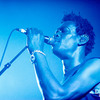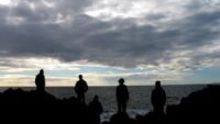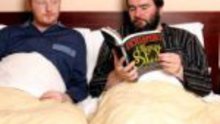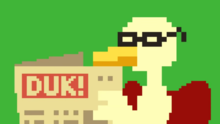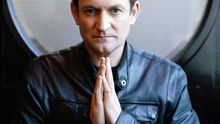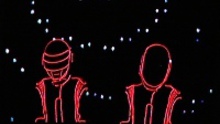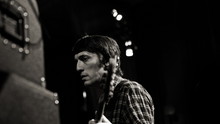Editors have come a long way since debut seven-inch ‘Bullets’ first landed on DiS’ doormat at the outset of 2005 (if we wanna be really pedantic, we could say since we promoted them in 2004 as Snowfield - Indie Points Ed). Their two albums to date, The Back Room and An End Has A Start both achieved platinum status amidst a wealth of critical acclaim, while their live shows have regularly sold out around Europe in the process...
Its also fair to say that the band have enjoyed something of a love/hate relationship with DiS and its readers, frontman Tom Smith even posting to defend his band on here back in the day.
‘Papillon’, the first single to be taken from forthcoming long player In This Light And On This Evening, is released on 11th October followed by the album twenty-four hours later. To say the record is a marked departure from their previous output would be something of an understatement, and while Smith’s trademark vocal is still omnipresent, its definitely a progression for a band many had wrongly written off as being formulaic.
DiS caught up with the diminutive frontman prior to him joining his band for rehearsals prior to their appearance on Later With Jools Holland, and found him in jovial spirits, even when broached on the aforementioned music forum spat of yore…
DiS: How are you and what are you up to at the moment?
Tom Smith: Everything’s good thank you. We’re in the promo run at the minute so we’ve had occasional gigs here and there, many interviews and we’re doing Later With Jools Holland this week so we’re just about to go down there and do rehearsals. It’s always an honour to be involved with that…
DiS: I guess it’s pretty much the only live music programme still around on terrestrial television these days.
TS: That’s scarily true. I grew up watching the show in my teens on Friday nights and I remember, if there was someone on I really enjoyed the night before, watching the repeat as well on the Saturday. I’ve seen many amazing performances on that show so to be invited back to play it for a third time is a bit nuts really!
DiS: It must be nice to be in that position where you’re being invited to play shows like Later… though, especially as there’ll be a lot of people tuning in specifically to see your band?
TS: Of course it is. We set our stall out quite early to make a series of records and make some kind of career out of it. We’ve never had ridiculous kinds of hype but we always tried to steer clear of flash-in-the-pan type scenes that can be around and eventually destroy certain bands. There’s not a lot you can do if that kind of thing occurs naturally but if we hadn’t chosen to tread the path we have, we probably wouldn’t be in this position now where we’re just about to bring out our third record.
DiS: That in itself is something of an achievement in the current climate.
TS: Quite. You have to remind yourself of that every now and again definitely.
DiS: Its been two years since An End Has A Start. Your new record In This Light And On This Evening seems to have brought a major shift musically for the band. What was the catalyst for this?
TS: I guess it just came from a desire, a willingness to move it on really. I don’t look around at the other three and think any of us have changed the reason why we’re making music. We just needed to find a new way of expressing that kind of drive. We felt coming off the back of An End Has A Start that we had to move somewhere different. We didn’t know at the time exactly where we were heading, but at the same time we knew we’d reached a point where weren’t inspired by what we were coming up with on guitars at that time. It left us with little option to change [in] the way [that] we have; I honestly believe if we’d tried to graft out another guitar heavy record we’d never have got through it.
DiS: For me, your set at Latitude was one of the highlights of the weekend, particularly the new songs which almost felt like a breath of fresh air in amongst the more familiar material from your first two albums. Do you and the band hold a similar viewpoint?
TS: It’s always good to hear positive comments when you try something new, but of course the flipside is that you can’t always please everyone and there’s a worry that some people could be alienated by the change in direction. Does it feel fresh? Yeah, definitely. To me, making this record had the same feeling as I got from making our debut record. The excitement of going back into the unknown gave us the impetus to start afresh. We’re all very proud of the last record but we set down to make it when we didn’t have many songs – twelve in total – and having toured The Back Room for two years, we were then faced with the pressure of having to get the follow-up out as soon as possible. Bands tend to come and go all the time and we didn’t want to be forgotten about; we wanted to quickly cement what we’d written and Jacknife Lee, who produced the album, actually helped us through some of the songwriting process as well. At the time we weren’t really sure where the songs were going so we ended up laying the tracks down bit by bit…drums, then bass and so on. Previously we’d written and rehearsed songs fully before we recorded them but with An End Has A Start it was literally a case of building them piece by piece. With this record I feel we’ve had more time to be creative again, learn new instruments, develop new sounds. In a way it felt like a kind of adventure.
DiS: You mention Jacknife Lee having a major influence on the previous album. With In This Light… you worked with another esteemed producer, Flood. Did he have any influence over how any of the songs ended up?
TS: Some of the songs were as good as finished before Flood) got involved; the title track is the main one which we demoed on our own in London at the final rehearsals before we started recording. Some of the songs we tried out in that session needed help in terms of the arrangements, and its always good to have someone there giving us advice on what we need to do to improve. ‘Papillon’ for example, which we demoed at the same time as ‘In This Light And On This Evening’, was just so full of ideas that it felt like a complete mess. By the time we got to the end of it we were all just tired. It was almost like we’d tried to put too much information into one thing, so it was important for someone to be on hand to sift through everything and advise us which bits to leave out, and then the next time we played it in the room everything clicked into place again and the energy felt natural rather than forced. Flood instilled a belief in us that we could actually make this record in a live way, which hadn’t occurred to us with it being mainly electronic based, and we weren’t really sure how to make it like that either. We actually ended up recording it like a rock and roll band; we set up a PA in the recording room and set it down straight to tape and all the songs were done in whole takes rather than bits here and bits there. We had twenty songs in total and it all fell into place fairly quickly. When you think of someone who has as much history as Flood, I guess you just expect to do it in a very modern way and be ironed out almost super-perfect, and yet it didn’t happen like that at all. It really was more about trying to capture a moment.
DiS: How did you eventually manage to whittle the album down from twenty songs to the nine that made the final cut? Do you see any of those that didn’t make it resurfacing in the future?
TS: It wasn’t easy to be brutally honest with you. All four band members have got slightly different views on things and we are a democracy, but it takes time I guess to try different orders and then go away and have discussions with each other and eventually we settled on those nine songs. Whenever we tried to add any more to it the album felt too long, almost like it had outstayed its welcome. We wanted to make In This Light… an album that flowed from start to finish rather than just two singles and a load of filler. I mean, the album as a complete entity is a dying format and we’re all very sad about that and in some ways, trying to cling onto it. Some of the other songs were close to making the record and there will be a five-track EP with initial copies of the record called ‘Cuttings #2’. We did a similar thing with our first album, as a lot of our fans couldn’t get hold of the early singles’ b-sides and that was called ‘Cuttings’, so I guess this is the follow-up! It just gives people a flavour of what was going on in the studio at that time. There are a couple of songs left over as well that I think fit in as more traditional b-sides, maybe into next year I’d say, and then we have two that aren’t quite finished that we thought were too good to release in their current state so we’re planning to go back to them at some point.
Video:Editors ‘Papillon’
---
DiS: Does this mean you’ve already started planning for the next album?
TS: Maybe. A version of one of those songs (‘No Sound But The Wind’) will be appearing on the ‘New Moon’ soundtrack in November.
DiS: Having heard the new album several times, its difficult not to focus on the more beat-laden approach you’ve taken with some of the songs on the record, particularly ‘Papillon’ and ‘Bricks And Mortar’. Do you see this being a direction the band will continue to pursue in the future?
TS: I definitely think there is further for us to go in this way. It feels like we’ve started something. I guess whenever it feels like we’ve become too safe and in many ways, obvious, we’ll try and shake things up a bit but its not as though we want to change dramatically with every record, it has to be a natural process. There is a lot of creativity around the band at the moment and we’re continually writing at present to the point where we may even do some more recording in the early part of next year so, who knows? We wanted to make In This Light… a groove-based record and I think that element comes across on ‘Papillon’ and ‘Bricks And Mortar’ because they’re quite long and playful, and to capture four people in that exact moment of concentration makes it quite special in itself.
DiS: By taking such a dramatic switch from being a guitar to keyboard-based band, was it especially difficult for all four members of the band to adapt?
TS: Not difficult as such…I mean, the keyboards we play in the purest form are very easy to play. Its not a technically hard thing to do; you basically just press a key or twiddle a knob and a sound comes out which you either like or you don’t! I’ve always written songs on the piano anyway. When I started putting together demos at home I used my Juno-106 and the way it made some of the chords sound – very bleak and cold – gave the songs a new personality that I don’t think any of our previous works had ever had before. Chris (Urbanowicz, guitar/keys) used to write most of his melodies on guitar as an interplay with the vocal melodies and that became a big part of our band, whereas with this record he wrote most of them on keys which in the grand scheme of things weren’t that much different to work with than what we’d done before.
DiS: Its interesting that you mention the bleak and cold sounds being particularly instrumental to this record. Right from when you first started you’ve been compared to Joy Division among others, and some would say that In This Light And On This Evening is your natural progression from that phase in the same way New Order moved onto Power, Corruption & Lies. Would you agree with that?
TS: It’s not as calculated as that. All the great bands have to evolve and try and do new things. I wouldn’t like to describe what we’re doing now in relation to anyone else. We didn’t know what to do and it didn’t feel right to make another guitar record so we moved into a more synthetic area. Of course I can see similarities in songs that we make with those of other bands – some comparisons baffle me too, but I’m not sure I’d describe the progression from An End Has A Start to In This Light And On This Evening as being akin to the same artists you just mentioned. There are a lot of guitar bands out there who kind of get bored with what their hands are doing and want to go and play with different things, simple as that.
DiS: I guess The Horrors are a perfect example at the moment as well as yourselves.
TS: Absolutely. They’ve made a great record, although when you listen to that album the melodies, the tension, the vocals are still quite similar to what they were doing before, and I think with us it’s the same. The main difference is really just the instrumentation. The only thing I’d say from our point of view is that in hindsight, In This Light… is perhaps a more logical progression from The Back Room than An End Has A Start.
Check back tomorrow morning for Part 2 of our chat with Tom Smith where he discusses the record in more detail and criticisms of their band, including a response he posted on the DiS Forum.
Editors will be playing the following shows in the UK and Ireland throughout October:-
1 London Oxjam Launch Gig (venue tbc)
7 Belfast St George’s Market
8 Dublin Olympia
9 Limerick Dolans
12 Edinburgh Picture House
13 Glasgow Barrowlands
14 Newcastle Academy
16 Manchester Academy
17 Leeds Academy
18 Norwich UEA
19 Bristol Colstan Hall
21 London Hammersmith Apollo
22 Sheffield Academy
23 Nottingham Rock City
25 Wolverhampton Civic Hall
26 Southampton Guildhall
The album In This Light And On This Evening is released through Kitchenware Records on Monday 12th October.




